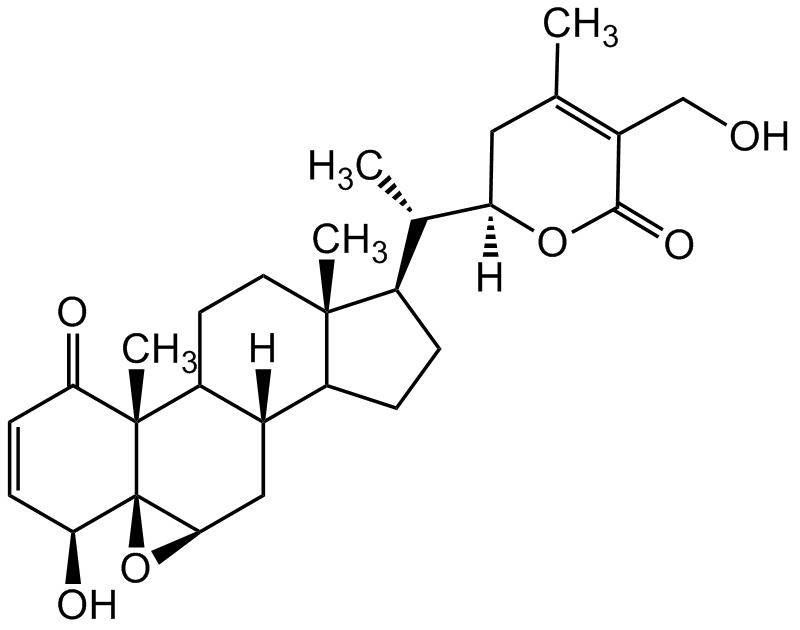
Chemical Structure
Withaferin A [5119-48-2]

AG-CN2-0490
Overview
- SupplierAdipoGen Life Sciences
- Product NameWithaferin A [5119-48-2]
- Delivery Days Customer10
- CAS Number5119-48-2
- CertificationResearch Use Only
- Estimated Purity>98%
- Molecular FormulaC28H38O6
- Molecular Weight470.6
- Scientific DescriptionChemical. CAS: 5119-48-2. Formula: C28H38O6. MW: 470.6. Isolated from Withania somnifera. Multifunctional anticancer compound. Amplifies the cellular antioxidant and/or detoxification system, suppresses inflammatory pathways, selectively inhibits tumor cell proliferation and induces apoptosis, suppresses tumor angiogenesis, blocks epithelial-to-mesenchymal transition (EMT), tumor invasion and metastasis, alters tumor cell metabolism, induces immunomodulation and downregulates cancer stem cells targets. Sensitizes resistant cancer cells to existing chemotherapeutic agents. Antioxidant. Induces cytoprotective enzymes (Nrf2-dependent as well), including SOD, HO-1 (heme oxygenase-1), catalase, glutathione peroxidise, glutathione s-transferase and NQO1. Anti-inflammatory agent. Inhibits COX-2 and iNOS expression (at protein and mRNA level) and PGE2 production. Prevents NF-kappaB activation by inhibiting activation of IKKbeta. Inhibits Helicobacter pylori-induced IL-1beta production by regulating NF-kappaB and directly inhibiting NLRP3 inflammasome activation. Antiproliferative agent. Induces G2/M phase cell cycle arrest, targeting CDKs. Shown to modulate STAT3, Bcl2, Notch receptors, Akt, Hsp90, EGFR, HER2 and PCNA. Disrupts the organization of microtubules and actin/microfilament. Stimulates F-actin cross-linking. Induces tumor cell apoptosis. Shown to induce ROS production. Activates mitochondrial apoptosis pathway through Bcl-2 downregulation and Bax upregulation. Shown to induce p53-dependent pathways and ER-stress. Activates the tumor suppressor protein PAR-4. Directly or indirectly inhibits selected other kinases, such MAPK or STAT3. Shown to inhibit hedgehog signalling pathway. Described to be an autophagy inducer and inhibitor. Potent inhibitor of the 20S proteasome beta5 subunit chymotrypsin-like activity. Potent angiogenesis inhibitor by modulating VEGF. Antimigratory, antiinvasive and antimetastatic compound. Targets TGF-beta, vimentin, MMPs and Notch receptors. Inhibits cancer stem cells targets, including aldehyde dehydrogenase 1 (ALDH1) activity. Alters cell line-specific the mRNA expression of cancer stem cell markers, such as Oct4, SOX-2, and Nanog. Reported to induce neuronal regeneration. Antidiabetic compound. Potent Leptin sensitizer, acting similar to Celastrol (Prod. No. AG-CN2-0460). - Multifunctional anticancer compound. Amplifies the cellular antioxidant and/or detoxification system, suppresses inflammatory pathways, selectively inhibits tumor cell proliferation and induces apoptosis, suppresses tumor angiogenesis, blocks epithelial-to-mesenchymal transition (EMT), tumor invasion and metastasis, alters tumor cell metabolism, induces immunomodulation and downregulates cancer stem cells targets. Sensitizes resistant cancer cells to existing chemotherapeutic agents. Antioxidant. Induces cytoprotective enzymes (Nrf2-dependent as well), including SOD, HO-1 (heme oxygenase-1), catalase, glutathione peroxidise, glutathione s-transferase and NQO1. Anti-inflammatory agent. Inhibits COX-2 and iNOS expression (at protein and mRNA level) and PGE2 production. Prevents NF-kappaB activation by inhibiting activation of IKKbeta. Inhibits Helicobacter pylori-induced IL-1beta production by regulating NF-kappaB and directly inhibiting NLRP3 inflammasome activation. Antiproliferative agent. Induces G2/M phase cell cycle arrest, targeting CDKs. Shown to modulate STAT3, Bcl2, Notch receptors, Akt, Hsp90, EGFR, HER2 and PCNA. Disrupts the organization of microtubules and actin/microfilament. Stimulates F-actin cross-linking. Induces tumor cell apoptosis. Shown to induce ROS production. Activates mitochondrial apoptosis pathway through Bcl-2 downregulation and Bax upregulation. Shown to induce p53-dependent pathways and ER-stress. Activates the tumor suppressor protein PAR-4. Directly or indirectly inhibits selected other kinases, such MAPK or STAT3. Shown to inhibit hedgehog signalling pathway. Described to be an autophagy inducer and inhibitor. Potent inhibitor of the 20S proteasome beta5 subunit chymotrypsin-like activity. Potent angiogenesis inhibitor by modulating VEGF. Antimigratory, antiinvasive and antimetastatic compound. Targets TGF-beta, vimentin, MMPs and Notch receptors. Inhibits cancer stem cells targets, including aldehyde dehydrogenase 1 (ALDH1) activity. Alters cell line-specific the mRNA expression of cancer stem cell markers, such as Oct4, SOX-2, and Nanog. Reported to induce neuronal regeneration. Antidiabetic compound. Potent Leptin sensitizer, acting similar to Celastrol (Prod. No. AG-CN2-0460).
- SMILESO=C1[C@@]2(C)[C@@]([C@H]3C[C@]4([H])C2CC[C@@]5(C)C4CC[C@@H]5[C@@H]([C@]6([H])OC(C(CO)=C(C)C6)=O)C)(O3)[C@@H](O)C=C1
- Storage Instruction-20°C,2°C to 8°C
- UNSPSC12352200
References
- Antitumor activity of withaferin A (NSC-101088): B. Shohat, et al.; Cancer Chemother. Rep. 51, 271 (1967)
- Withaferin A is a potent inhibitor of angiogenesis: R. Mohan, et al.; Angiogenesis 7, 115 (2004)
- Neuritic regeneration and synaptic reconstruction induced by withanolide: A: T. Kuboyama, et al.; Br. J. Pharmacol. 144, 961 (2005)
- The tumor proteasome is a primary target for the natural anticancer compound Withaferin A isolated from "Indian winter cherry": H. Yang, et al.; Mol. Pharmacol. 71, 426 (2007)
- The tumor inhibitor and antiangiogenic agent withaferin A targets the intermediate filament protein vimentin: P. Bargagna-Mohan, etal.; Chem. Biol. 14, 623 (2007)
- Withaferin A induces apoptosis by activating p38 mitogen-activated protein kinase signaling cascade in leukemic cells of lymphoid and myeloid origin through mitochondrial death cascade: C. Mandal, et al.; Apoptosis 13, 1450 (2008)
- Inhibition of monosodium urate crystal-induced inflammation by withaferin A: E.P. Sabina, et al.; J. Pharm. Pharm. Sci. 11, 46 (2008)
- Withaferin A targets heat shock protein 90 in pancreatic cancer cells: Y. Yu, et al.; Biochem. Pharmacol. 79, 542 (2010)
- Notch-1 inhibition by Withaferin-A: a therapeutic target against colon carcinogenesis: S. Koduru, et al.; Mol. Cancer Ther. 9, 202 (2010)
- Withaferin A inhibits activation of signal transducer and activator of transcription 3 in human breast cancer cells: J. Lee, et al.; Carcinogenesis. 31, 1991 (2010)
